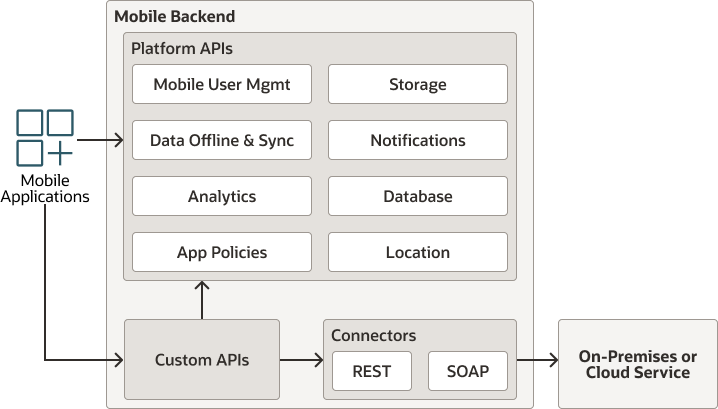Plan Your Oracle Mobile Hub Application
Plan during your design phase what components you'll leverage to construct your application.
Considerations for Building a Mobile Application
Building a mobile application consists of several discrete stages. It is important to understand the considerations and requirements of each stage before you select your tools and start to build your application.
To begin with, it is often a good idea to build a façade API layer. This is important because SaaS vendor APIs are often complex and extensive, and you might not want to expose those complete APIs to a client application, even at the code level. Additionally, application performance, API call limits, custom data security, and other considerations must be taken into account. This façade consumes the service APIs and exposes a clean and precise API to the client.

Description of the illustration mcs-api-gateway.png
The next step is to build the user interface layer. You want to develop a user interface quickly and efficiently, while retaining flexibility in how the UI is rendered as well as the flexibility to change screens with minimal effort.
The final step in building this application is to integrate the workflow engine with the UI.
Using Oracle Cloud services such as Oracle Mobile Hub and Oracle Integration helps you to perform each of these steps in an efficient and agile manner. Oracle Mobile Hub APIs are built using JavaScript running in Node.js. This allows you to issue a single call to Oracle Mobile Hub and then leave it to Oracle Mobile Hub to issue all the required calls to the backend service asynchronously. The results are aggregated and returned as a single payload to the client. This dramatically reduces the network traffic between Oracle Mobile Hub and the client, which improves performance. Optionally, you can use Oracle Integration to provide single sign-on (SSO) between the services.
About Mobile Backends
A mobile backend within Oracle Mobile Hub is a group of secure APIs and other resources used for developing client-server mobile applications.
You can use Oracle Mobile Hub to group and manage different APIs that together define a mobile backend.
In Oracle Mobile Hub, you can have multiple backends, each serving different client mobile applications. However, you can also have multiple APIs shared among different backends. The following image shows a typical mobile backend architecture in Oracle Mobile Hub:
mobile-backend-architecture-oracle.zip
When a client mobile application accesses an API through Oracle Mobile Hub, it's always within the context of a mobile backend. The application can authenticate using credentials defined within Oracle Mobile Hub (OAuth or basic HTTP authentication) specific to the mobile backend or through an identity store (or social log-in provider) that is mediated by your mobile backend. If the called API includes calls to other APIs within the backend, the identity and credentials of the original caller are propagated through the chain of calls.
Working in mobile backends helps you to visualize the resources available for the target apps and how they will work together. In addition, you can use the mobile backend security context to test calls to your APIs, even in the earliest stages of development.
